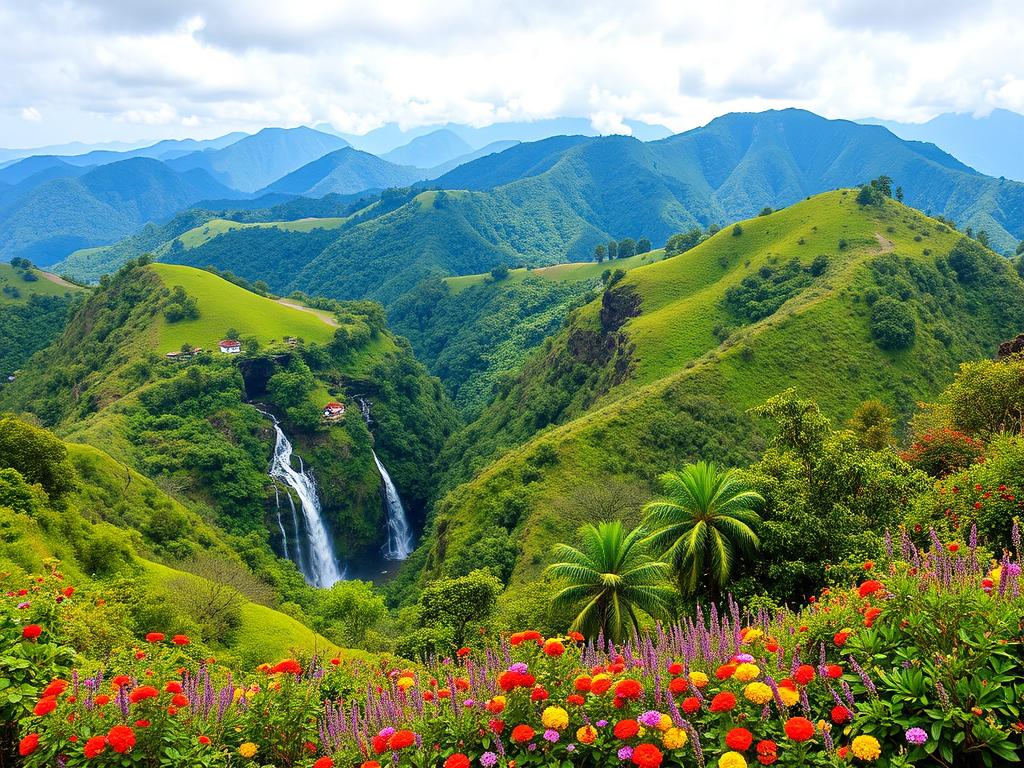Biodiversity Hotspots of India: The Unique Species of the Western Ghats and the Himalayas

India’s Western Ghats and Himalayas are two of the world’s most important ecological hotspots. They are home to a wide variety of unique species. These areas have lush rainforests, alpine meadows, and tall mountains.
The Western Ghats, a UNESCO World Heritage site, stretches over 1,600 kilometers along India’s western coast. It has 7,400 plant species, 1,814 vertebrate species, and 139 mammal species. The Himalayas, covering five countries, boast over 10,000 plant species and many endangered animals like the snow leopard and red panda.

These biodiversity hotspots are key to keeping our environment balanced. They support the lives of millions of people in India. They also provide water, stop monsoon winds, and help fight climate change by absorbing carbon dioxide.
Understanding India’s Major Ecological Hotspots
India boasts two of the world’s most vital biodiversity hotspots: the Western Ghats and the Himalayas. These areas are known for their high number of unique species and the danger of losing their habitats.
What Makes a Region a Biodiversity Hotspot
A biodiversity hotspot is a place with lots of different species and is at risk of being destroyed. It must have at least 1,500 plant species found nowhere else and have lost 70% of its original habitat.
Geographical Significance of Indian Hotspots
The Western Ghats and the Himalayas meet these criteria. They have unique geology, varied climates, and landscapes. This diversity has led to many species found only in these places.
Climate and Topographical Features
The Western Ghats have tropical forests, while the Himalayas have everything from forests to alpine tundra. These environments are key for the climate, water, and home to many endemic species.
| Biodiversity Hotspot | Key Characteristics |
|---|---|
| Western Ghats | – Tropical and subtropical moist broadleaf forests – High endemism in flora and fauna – Crucial for regulating climate and water cycles |
| Himalayas | – Range of ecosystems from subtropical forests to alpine tundra – High endemism and diverse flora and fauna – Vital for regulating regional and global climate |
Biodiversity of Western Ghats and Himalayas: A Comprehensive Overview
The Western Ghats and Himalayas are key biodiversity hotspots in India. They hold about 30-40% of the country’s plant species. These areas are home to unique species like the Nilgiri tahr and the snow leopard.
The Western Ghats cover over 160,000 square kilometers. They have diverse ecosystems, from tropical forests to grasslands. The Himalayas have around 18,000 plant species, with 5,000 being unique to this region.
These regions are crucial for plant diversity conservation. Studying their plant species helps us understand their ecosystems better. This knowledge is vital for protecting these biodiversity hotspots.
But, these areas face big challenges like deforestation, habitat fragmentation, and climate change. New species discoveries highlight the need for ongoing conservation efforts.
| Region | Total Plant Species | Endemic Plant Species | Endemism Rate |
|---|---|---|---|
| Western Ghats | Over 4,000 | Over 3,200 | Up to 80% |
| Himalayas | Approximately 18,000 | Around 5,000 | Varies |
The Western Ghats and Himalayas are rich in biodiversity. They attract researchers and conservationists. Protecting these areas is essential for preserving their natural heritage.
 Ayurveda and Medicinal Plants: Exploring Traditional Indian Medicine and Modern Scientific Research
Ayurveda and Medicinal Plants: Exploring Traditional Indian Medicine and Modern Scientific Research
Endemic Species Distribution in the Western Ghats
The Western Ghats in India are a biodiversity hotspot. They are home to many unique plants and animals found nowhere else. These species show the area’s ecological importance and why we must protect it.
Rare Flora Species
The Western Ghats have a wide variety of rare plants. You can find the colorful Impatiens species and the striking Strobilanthes kunthiana shrub. These plants are key to the area’s biodiversity. They remind us of the need for biodiversity research and conservation efforts.
Unique Fauna Categories
The Western Ghats also have a variety of endemic species. There’s the purple frog (Nasikabatrachus sahyadrensis) and the Malabar tree toad (Pedostibes tuberculosus). These animals add to the region’s biodiversity. They show why we must keep working to protect these species.
Recently Discovered Species
New discoveries in the Western Ghats amaze scientists. They’ve found new caecilians and frogs. These discoveries show the area’s unexplored biodiversity potential. They highlight the need for ongoing biodiversity research to learn more about this unique place.
| Endemic Species | Habitat | Conservation Status |
|---|---|---|
| Impatiens spp. | Western Ghats | Vulnerable |
| Strobilanthes kunthiana | Western Ghats | Endangered |
| Nasikabatrachus sahyadrensis (Purple Frog) | Western Ghats | Endangered |
| Pedostibes tuberculosus (Malabar Tree Toad) | Western Ghats | Vulnerable |
Himalayan Ecosystem: A Haven for Unique Wildlife
The Himalayan ecosystem is a true marvel, home to a wide variety of wildlife. These animals are adapted to the extreme altitudes and temperatures of the region. Iconic species like the snow leopard, Himalayan brown bear, and mesmerizing pheasants call this place home.
Recent research has uncovered new snake species in the genus Liopeltis. This highlights the incredible biodiversity in the Himalayas. It shows how diverse and rich this ecosystem is.
But, the Himalayan region faces a big threat from climate change. Rising global temperatures and changing precipitation patterns disrupt the balance of these high-altitude ecosystems. This puts many species at risk. Conservationists and policymakers are working hard to protect the Himalayan biodiversity. They aim to ensure its survival in the face of these challenges.
| Key Himalayan Wildlife Species | Conservation Status |
|---|---|
| Snow Leopard | Vulnerable |
| Himalayan Brown Bear | Least Concern |
| Himalayan Monal Pheasant | Least Concern |
| Himalayan Quail | Critically Endangered |
The Himalayan ecosystem is a treasure trove of biodiversity. It shows the incredible adaptations and resilience of the region’s wildlife. As we work to protect this natural wonder, understanding the Himalayan biodiversity is key. We must take action to safeguard its future.
Migratory Patterns and Seasonal Biodiversity Changes
India’s ecological hotspots, like the Western Ghats and the Himalayas, are rich in biodiversity. They are also key for migratory birds. These birds come in winter, looking for places to breed and plenty of food.
Winter Migration Routes
Vetal Tekdi in Pune is a key stop for birds like the Common Cuckoo and Jacobin Cuckoo. These birds are important for the area’s balance. Their migrations help keep the ecosystem healthy.
Breeding Grounds and Habitat Preferences
The Western Ghats and the Himalayas are perfect for birds to breed. They have everything these birds need for their young. Knowing what birds need helps us protect them better.
Impact of Climate Change on Migration
But, climate change is changing how birds migrate. Some birds are changing their paths or when they move. Events like the Vetal Tekdi Birding Marathon help us understand these changes. They also get people involved in saving these important places.
 “I’m Alive” by Céline Dion: The Technology That Keeps Music Timeless
“I’m Alive” by Céline Dion: The Technology That Keeps Music Timeless
Conservation Challenges in Both Regions
India’s biodiversity hotspots, the Western Ghats and the Himalayas, face big deforestation threats, conservation efforts, and climate change impacts. These areas are home to a vast array of plants and animals. But, human activities are putting their delicate ecosystems at risk.
The Western Ghats have lost over 33% of their forests. The Himalayas are seeing glaciers melt fast because of climate change. This is hurting the homes of many rare plants and animals. Despite efforts, it’s hard to keep up with these problems.
- Deforestation and habitat loss are big problems, caused by farming, cities, and roads.
- Things like mining and logging are also harming these areas, upsetting their natural balance.
- In the Himalayas, more people and tourists mean more trash, less water, and soil erosion. This is very bad for the environment.
But, there are still efforts to save these special places. Programs like protected areas, community projects, and green development are trying to help. Yet, we need to do more, faster, to fight deforestation threats and climate change impacts.
The Western Ghats and the Himalayas are not just important for India. They are also key biodiversity hotspots worldwide. It’s crucial to keep their ecosystems healthy. This is important for India’s future and the planet’s.
Indigenous Communities and Their Role in Conservation
The indigenous communities of the Western Ghats and the Himalayas have a long history of caring for the environment. They have a deep connection to the land and use sustainable practices to protect it. This helps keep the biodiversity of these areas rich and diverse.
Traditional Conservation Practices
In the Western Ghats, local communities have sacred groves that act as biodiversity refuges. These untouched forest patches, linked to temples or deities, have preserved native plants and animals for centuries. In the Himalayas, communities practice sustainable farming and grazing. This ensures that humans and nature live in harmony.
Community-Based Protection Initiatives
Many initiatives have been started to help indigenous communities protect their ecosystems. Eco-development committees, for example, involve local people in managing protected areas. This way, their traditional knowledge and practices are used in decision-making. These efforts not only protect biodiversity but also help the livelihoods of indigenous people, promoting sustainable tourism and conservation efforts.
The indigenous communities of the Western Ghats and the Himalayas have cared for these areas for generations. By supporting and empowering them, we can protect these unique ecosystems for the future.
Climate Change Impact on Species Distribution
Climate change is changing where species live in the Western Ghats and the Himalayas. These are India’s key places for biodiversity. In the Western Ghats, frogs and toads are moving up mountains because it’s getting warmer.
In the Himalayas, trees are growing higher, and plants are changing their growth patterns. This is upsetting the balance of these ecosystems.
It’s important to study biodiversity to understand and fight these changes. We need to watch these areas over time and use climate models. This helps us see how climate change affects plants and animals.
These efforts are key to keeping the biodiversity of these areas alive. As the climate keeps changing, we must work together to protect these ecosystems. By using the latest research, we can find ways to save the species living in these hotspots.
 Barranquilla Carnival: Colombia’s Most Spectacular Cultural Celebration
Barranquilla Carnival: Colombia’s Most Spectacular Cultural Celebration






